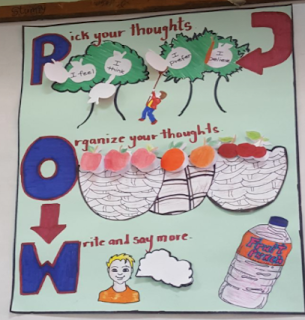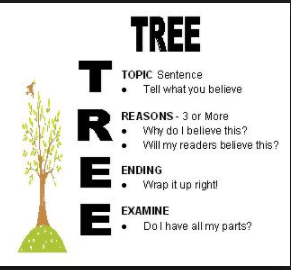“Start writing, no matter what. The water does not flow until the faucet is turned on”. These are the words of an American novelist by the name of Louis L'Amour. Our understanding of this quote is that students will not acquire the skill of writing or know their abilities unless they are given the opportunity to write and practice their writing. Writing is a process, not a product and every child must be taught how to write. Therefore, teachers are responsible for fostering their students’ writing and in order to teach students how to write, they must know and understand the process of writing. Regardless of the approach or format that are used to teach writing, there are some things that children need. In light of this, we learnt in last week’s sessions about seven essentials of writing, the stages of writing development, and the six traits plus one of writing.
To begin with, we discovered that one of the essentials of writing is allowing students to have regular feedback about their writing from their teachers and peers. For this reason, writing is deemed a social act as it allows interactions with others. These interactions help to develop students’ writing as well as to build their self-confidence. As we reflected on our experiences in school, we realized that we seldom shared our written pieces with others. The interaction was predominantly between the teachers and ourselves. However, we know now that it is important for students to share their work with teachers as well as their peers.
Moreover, we experienced two ‘aha moments’ during one of the lectures. Firstly, we learnt that students should be given the opportunity to choose their topics when they are writing. However, we discovered that constantly giving students a choice will cause various problems. Students can constantly choose topics that are simple and less challenging for them and they can also refuse to write on the topic(s) that was selected by the teacher.
Secondly, we discovered that we have to teach writing and not just give students writing assignments to complete. When we reflected on our primary and secondary school experiences with writing, we saw that we mainly had writing assignments to complete. During the lecture, we realized that we cannot teach writing to students based on our experiences and/or how we learnt. We have to be different in our teaching of writing.
Furthermore, throughout the course of the week we learnt about the traits of writing which can be used to improve students’ writing. We discovered that these six plus one traits are closely linked to the stages of the writing process.
 |
| Image showing the connection between the writing process and the six plus one traits of writing
|
It is important for teachers to model the use of these writing traits and emphasize their importance so that the students can recognize how they contribute to improving their writing skills. As it relates to the voice writing trait, we discovered that there is a distinct difference between the writer’s voice and tone. The writer’s voice refers to his or her own distinctive style of writing which may be influenced by their personality, vocabulary, experience and way of thinking. On the other hand, the writer’s tone reflects the mood of the writer. Therefore, a piece of writing can encompass different tones but there will only be one voice. It is the voice that differentiates one writer from another.
As we continued to reflect on our week, there were some general areas which we liked that caused the sessions to be enjoyable. To begin with, we found the ‘What do we know so far?’ slides at the beginning of the lectures and the questions that were posed at the end of every slide to be very useful. These “so far” slides help to recap what we learnt in previous sessions and activate our prior knowledge while the questions allow us to monitor our own understanding of the content. Despite this, we believe that the lecturer should select students to answer some of these questions instead of allowing us to answer collectively. We suggest that the lecturer chooses the students to answer the questions on the slides because it will indicate whether they understand the information or not.
Moreover, we liked that the lecturer gave students the opportunity to read portions of the information on the slides during the sessions. Although the lecturer’s voice was clear and comprehensible, listening to our peers while they read helped to maintain our attention and to an extent, retain more information. One suggestion that we have for future sessions is to have students explaining or summarizing the information on the slides during or after they read.
Lastly, there is one thing that caught our attention in last weeks' sessions and we greatly appreciate it. We loved that the lecturer always seizes the opportunity to teach us when a teachable moment arises. Although it was a diversion from the original lesson, the information that was taught was very useful and it provided clarification. For instance, the use and purpose of the semicolon ( ; ).
 |
Image showing the lecturer's teachable moment on the correct use of punctuation marks
|









